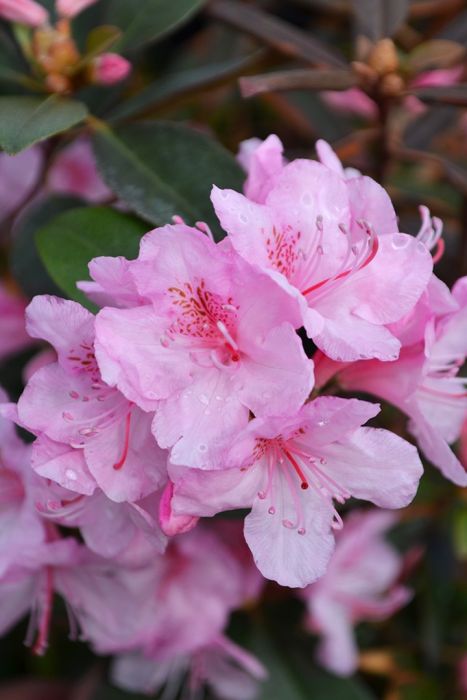Growing Azaleas & Rhododendrons
The experts at Gertens offer advice on how to grow Azaleas and Rhododendrons and how to take care of them.





Compact plant that blooms with rosy pink flowers in spring. Mahogany red fall color.
Elevate your landscaping with Gertens' unmatched variety of shrubs! Selecting the right shrubs for your backyard can enhance its beauty and functionality. Consider factors like sunlight, soil type, and mature size when choosing shrubs. For sunny areas, flowering shrubs like roses or hydrangeas can add color and charm. In shady spots, opt for shrubs like azaleas or hostas. Evergreen shrubs provide year-round interest and privacy, while deciduous shrubs offer seasonal color changes. At Gertens, we offer a wide selection of shrubs to suit every backyard need.
Aglo Rhododendron | Rhododendron 'Aglo'
Height: 4 feet
Spread: 4 feet
Sunlight: full sun to partial shade
Hardiness Zone: 4b
Brand: Gertens
Description:
A beautiful broadleaf evergreen shrub featuring light pink flowers in spring and a dense, compact habit, very hardy, interesting fall coloration; absolutely must have well-drained, highly acidic and organic soil, use plenty of peat moss when planting
Ornamental Features
Aglo Rhododendron is smothered in stunning clusters of lightly-scented shell pink trumpet-shaped flowers with a red blotch at the ends of the branches in early spring. It has green evergreen foliage. The narrow leaves turn an outstanding purple in the fall, which persists throughout the winter.
Landscape Attributes
Aglo Rhododendron is an open multi-stemmed evergreen shrub with a more or less rounded form. Its relatively coarse texture can be used to stand it apart from other landscape plants with finer foliage.
This shrub will require occasional maintenance and upkeep, and should only be pruned after flowering to avoid removing any of the current season's flowers. It has no significant negative characteristics.
Aglo Rhododendron is recommended for the following landscape applications;
Planting & Growing
Aglo Rhododendron will grow to be about 4 feet tall at maturity, with a spread of 4 feet. It has a low canopy. It grows at a slow rate, and under ideal conditions can be expected to live for 40 years or more.
This shrub does best in full sun to partial shade. It requires an evenly moist well-drained soil for optimal growth, but will die in standing water. It is very fussy about its soil conditions and must have rich, acidic soils to ensure success, and is subject to chlorosis (yellowing) of the foliage in alkaline soils. It is somewhat tolerant of urban pollution, and will benefit from being planted in a relatively sheltered location. Consider applying a thick mulch around the root zone in winter to protect it in exposed locations or colder microclimates. This particular variety is an interspecific hybrid.
Aglo Rhododendron makes a fine choice for the outdoor landscape, but it is also well-suited for use in outdoor pots and containers. Because of its height, it is often used as a 'thriller' in the 'spiller-thriller-filler' container combination; plant it near the center of the pot, surrounded by smaller plants and those that spill over the edges. It is even sizeable enough that it can be grown alone in a suitable container. Note that when grown in a container, it may not perform exactly as indicated on the tag - this is to be expected. Also note that when growing plants in outdoor containers and baskets, they may require more frequent waterings than they would in the yard or garden. Be aware that in our climate, most plants cannot be expected to survive the winter if left in containers outdoors, and this plant is no exception. Contact our experts for more information on how to protect it over the winter months.
| Gerten Grown Plants | Gerten Grown Plants |
|---|---|
| Available for Pre-Order | Yes |
| Sun Preference | Full-Sun, Part-Sun |
| Mature Height (Range) | 2 - 5 feet |
| USDA Hardiness Zone | 3, 4, 5, 6, 7 |
| Common Family Name | Azalea |